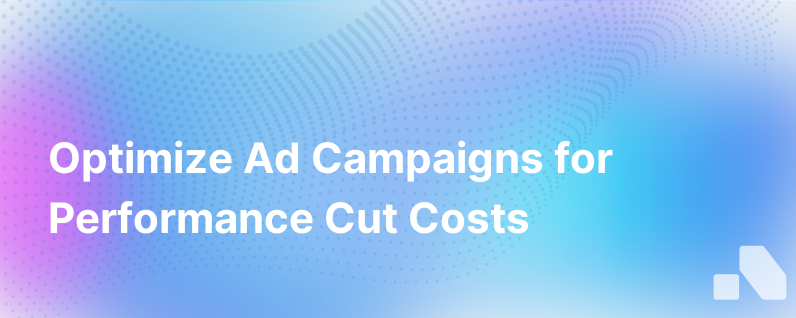These Ad Campaign Optimization Tips Increase Performance And Decrease Spend
Published on November 25, 2023 by Sawyer Middeleer
In the dynamic world of digital advertising, creating an ad campaign is just the beginning. The real mastery lies in fine-tuning and optimization, ensuring that each dollar spent not only reaches its audience more effectively but also delivers the best possible return on investment. As marketers, we've grown accustomed to the adage that says, "Half the money I spend on advertising is wasted; the trouble is I don't know which half." But in today’s digital landscape, with the vast amount of data and analytics tools at our fingertips, insights guide our campaigns towards efficiency and effectiveness. In this article, let's delve into specific strategies you can employ to optimize your ad campaigns, reduce spend, and ultimately, drive performance.
Understanding the Goals
Before diving into optimization, it's essential to have unambiguous campaign goals. These goals could range from increasing brand awareness to driving sales, but they must be measurable. Once the purpose of the campaign is evident, subsequent optimization decisions become clearer and metrics easier to analyze.
Targeting the Right Audience
The most beautifully crafted ad will fall flat if it doesn't reach the right eyes. Use data analytics to narrow down your ideal customer profile based on demographics, interests, behavior, and even psychographics to improve the likelihood of engaging your intended audience.
Dynamic Creative Optimization (DCO): Utilize DCO technology to automatically create personalized ad creative that speaks directly to different segments within your target audience based on real-time data and user behavior. This means instead of a generic message, your potential customer sees an ad tailored to their preferences, which significantly hikes the chances of conversion.
Keyword and Audience Refinement
For PPC campaigns, performing regular keyword audits can uncover both high-performing and underperforming keywords. Eliminating or reducing bidding on ineffective keywords curbs unnecessary spend, while increasing investment in ones with a proven track record boosts overall campaign performance.
Layer Different Targeting Methods: Rather than relying on a single targeting method, layer different strategies, such as contextual targeting with retargeting. This not only widens your net but also allows you to nurture leads at various stages in the funnel.
Ad Placement Optimization
Where your ads appear is crucial. Analyze performance metrics across various platforms and ad positions, and optimize by concentrating more of your budget on the placements yielding the best results. Avoid underperforming sites that can drain budgets without contributing to your goals.
Use of Heatmaps for Website Ads: If you're advertising on your own or others' websites, heatmap analysis can show where users are most likely to click, allowing you to strategically place ads for maximum visibility and engagement.
Scheduling and Frequency
Make sure your ads are shown at the most opportune moments. Ad scheduling can prevent your campaign from wasting money during off-peak hours. Similarly, frequency capping ensures that your ads do not overwhelm users, avoiding ad fatigue that can lead to brand resentment or blind spots.
Testing and Iteration
In digital marketing, complacency is the enemy of performance. Always test different versions of your ads (A/B testing) to iterate towards the most effective messaging, design, and call-to-action.
Multivariate Testing: Take A/B testing a step further with multivariate testing, where multiple variables are tested simultaneously to analyze how different elements interact with one another.
Landing Page Optimization
The landing page is your ad's promise-land – make sure it delivers what your ad suggests. Landing pages must be relevant and optimized for conversion. Use A/B testing here too, to see what layout, copy, and calls to action yield the best results.
Smart Bidding Strategies
Embrace the power of AI with smart bidding strategies in platforms such as Google Ads. These strategies adjust your bids in real-time based on the likelihood of a search converting. Over time, they learn which types of bids are most effective and adjust accordingly to get the most bang for your buck.
Geo-targeting Adjustments: Refine your bidding strategies by considering geographical performance. In regions where your ads perform well, consider increasing bids to capitalize on strong markets.
Scrutinizing Analytics
Constantly monitor your campaign’s analytics, keeping an eye on metrics such as click-through rates (CTR), conversion rates, and cost per acquisition (CPA). Use these insights to pivot and tweak your campaigns.
Utilizing UTM Parameters: Track the performance of different traffic sources more accurately by adding UTM parameters to URLs. By deepening your analytics, you'll understand which sources are most valuable.
Harnessing the Power of AI
AI-driven platforms like Aomni can identify performance patterns that might not be evident to the human eye. By leveraging such technologies, you can optimize campaigns based not just on historical data but predictive analytics as well.
Predictive Audience Analysis: Use AI to predict future consumer behavior and adjust campaigns before trends change, putting you ahead of the competition and increasing your ROAS (Return On Ad Spend).
Conclusion
By implementing these optimizations, marketers can expect not just a better-performing ad campaign but also a more efficient budget expenditure. However, the optimization process is ongoing and must remain responsive to changing market dynamics, consumer behaviors, and technological advancements. Paying close attention to data and a willingness to experiment are key to maintaining a high-performing, cost-effective digital ad campaign. Remember, every ad budget has an optimal destination; it's your job to navigate your resources efficiently and effectively towards that horizon.